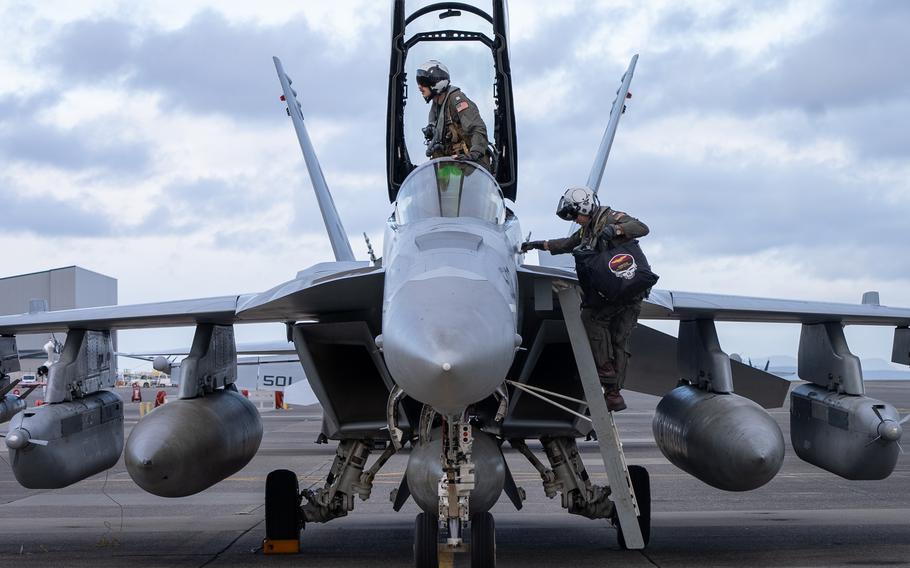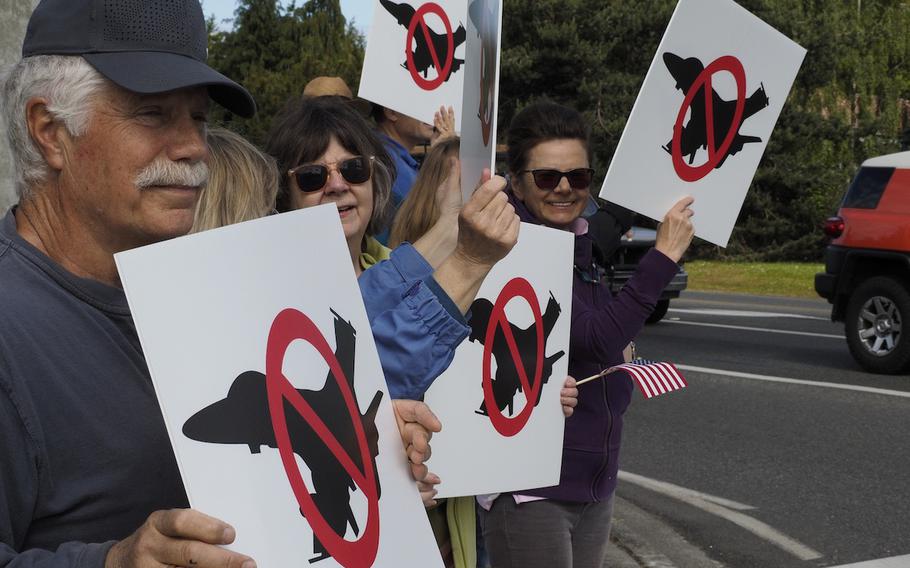
Navy Lts. Zach Miller and Keith Henzer climb out of a EA-18G Growler at Naval Air Station Whidbey Island, Wash., in December 2024. (Jacquelin Frost/U.S. Navy)
SEATTLE — The Navy has rejected a proposal to move its Growler electronic attack squadrons from Naval Air Station Whidbey Island to a base in Southern California, saying the move would cost $800 million and mean abandoning decades of building and expertise accumulated at their base on Puget Sound in Washington.
“Naval Air Facility El Centro is not a reasonable alternative,” said Lt. Cmdr. James Smith, the operations officer at NAS Whidbey Island.
The Navy’s position was announced at three public meetings held recently on Whidbey Island to solicit local feedback on the analysis that it must submit to U.S. District Court Judge Richard Jones in Seattle by May 1.
The analysis was required after some residents and community groups had sued the Navy over its 2019 decision to increase the number of Growler jets at Whidbey Island from 82 to 118.
The Growler controversy is the latest friction between some members in the local community and the Navy over flight operations at the Whidbey Island base.

Residents protest in June 2019 against the Navy increasing the maximum number of EA-18G Growler jets based at Naval Air Station Whidbey Island in Washington state. (Citizens of Ebey’s Reserve)
Since the 1960s, the Navy’s aircraft at Whidbey Island has changed from propeller-driven planes and flying boats to long-range, turbo-prop reconnaissance aircraft such as the P-3 Orion to jets such as the A-6 Intruder and its electronic warfare variant, the EA-6 Prowler.
Organized opposition to jet noise began in 1980 with Whidbey Island Sound Environment, or WISE, protesting the noise of the Prowler jets.
The air station’s focus now is training for the Growler’s unique role — attacking enemy radar and anti-aircraft missile installations to clear the way for attack squadrons to hit a location’s main targets. The flight training includes terrain-hugging, low-level flying and touch-and-go takeoffs and landings at an auxiliary airfield on the island with the dimensions of an aircraft carrier deck.
Critics of the Navy’s training contend the service has increased the amount of noise, pollution and other impacts on island residents and those living in different locations around northern Puget Sound.
Terra Huey, who lives on Whidbey Island, is a leader of the Sound Defense Alliance. The group serves as an umbrella organization for groups with about 3,000 affiliates on Whidbey Island and several surrounding counties.
“I went to the Navy’s meeting in Oak Harbor and it felt most like an open house to give the Navy’s information instead of having a discussion,” Huey said. “The draft analysis is what they are going to go to the court with.”
Huey said groups will continue to try to engage the Navy in what she thinks are more productive methods to find a way to coexist better.
“We’re not asking them to close the base,” she said. “But if doing more things at El Centro is a way to lighten the load on the community here, they should do it. We need cost-effective alternatives that don’t put our people in harm’s way or their health at risk.”
Huey pointed to a 2024 University of Washington study that showed 74,000 people living, working or going to school near the base are exposed to noise levels associated with adverse health effects that can include hearing loss, sleep disturbance and cardiovascular disease.
“We basically want more transparency, more notice when they are flying, less operations, flying for not as long or as frequently,” she said.
But the Navy has argued it trains to prepare pilots to win and survive in combat.

A banner in June 2019 protesting the Navy increasing the maximum number of EA-18G Growler jets based at Naval Air Station Whidbey Island in Washington state. (Citizens of Ebey’s Reserve)
The federal judge found the Navy has met most environmental standards but ordered the service to resubmit portions of its Environmental Impact Statement dealing with air pollution, impact of noise on schools and disruption of shorebird activity.
The judge also wants the Navy to justify why all or most of the base operations at Whidbey Island couldn’t be moved to another location. The focus has been on moving to Naval Air Facility El Centro, where the Navy already conducts a large amount of flight and weapons training in the sparsely populated areas in Imperial County, Calif., near the border with Mexico.
Following several rounds of base closings and consolidations over the years, Whidbey Island has become the home base for all the Navy’s electronic warfare jets. It also is home to eight squadrons of P-8 Poseidons that provide long-range reconnaissance for the Navy.
El Centro is now a center for squadrons from throughout the Navy to visit for flight and weapons training. Other services also use the weapons ranges and flight corridors. It’s also the wintertime home of the Blue Angels, the Navy’s elite flight demonstration team.
The Navy has told the judge that a move to the El Centro facility goes against Pentagon policy to bring squadrons together instead of spreading them out over large geographic areas.
“The Naval Air Facility El Centro alternative is inconsistent with and contrary to Navy policy to maximize the efficiency of operations by collocating operational squadrons with support functions, training ranges, and airfields for squadron-level training, fails to maximize existing resources, and would result in unreasonable duplication of functions and infrastructure at significant cost and delay, while creating unnecessary inefficiencies and detrimentally affecting operational readiness,” the Navy states in its analysis. “These and other operational impacts increase the risk to mission accomplishment.”
The move would also “impose additional and unnecessary burdens on sailors and their families,” the Navy said. Officials at the Whidbey Island public meeting said building or finding housing for the 7,500 sailors and air crew at the air station would be difficult. The move would also require spouses to give up jobs and children to change schools.
“Accordingly, the Navy has eliminated this alternative from detailed consideration and does not carry it forward,” according to the analysis.
Citizens of Ebey’s Reserve, or COER, is a group aligned with the Sound Defense Alliance and seeks to preserve the rural character of Ebey’s Landing National Historic Reserve near Coupeville, an undeveloped area near the base.
COER leader Bob Wilbur said he thought the meetings were a recap of the Navy’s stance instead of an attempt to find common ground with local residents.
“It was just more of the same. It fell well short,” he said. “There was a lot of talk about the deficiencies of a move to El Centro, but nothing really on the impact on the community here. I would have liked to have seen a breakdown of the economic costs of leaving the Growlers here.”
Wilbur said there is a range of opinions among activists, with some wanting the base shuttered and others willing to keep the jets as neighbors if the Navy moves the high-decibel, touch-and-go flight training.
“That would be a compromise that keeps the base alive, which I think most people want, and mitigates the worst impacts,” he said.
The Navy said noise from the Growlers only led to a one-month delay in attaining grade-level reading comprehension on standardized tests among elementary school students.
The Navy analysis also found disruption of breeding and nesting of four species of seabirds was negligible with most living and feeding outside of the areas with the highest decibel impact.
Greenhouse gas levels emitted by the extra 36 Growlers brought to the base are relatively insignificant, as only a fraction of the aircraft at Whidbey Island are flying at the base at any given time, the Navy said.